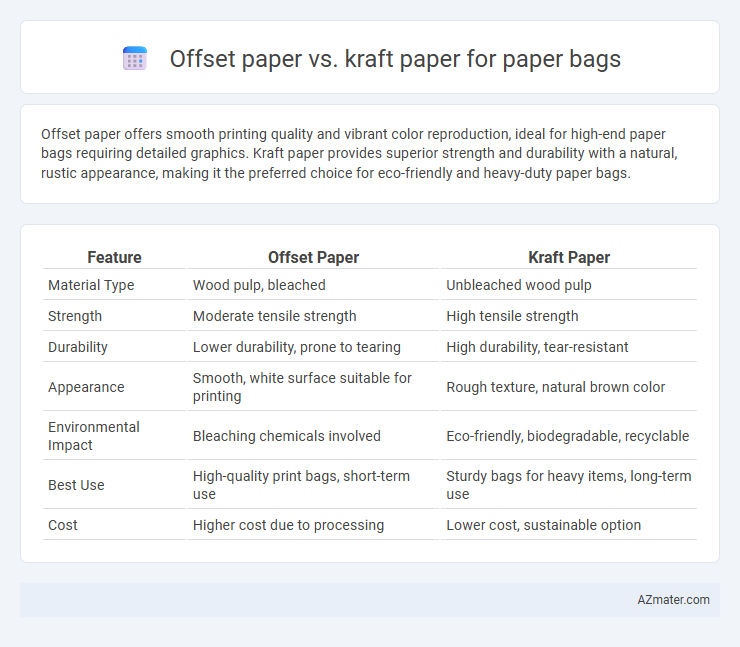Offset paper offers smooth printing quality and vibrant color reproduction, ideal for high-end paper bags requiring detailed graphics. Kraft paper provides superior strength and durability with a natural, rustic appearance, making it the preferred choice for eco-friendly and heavy-duty paper bags.
Table of Comparison
| Feature | Offset Paper | Kraft Paper |
|---|---|---|
| Material Type | Wood pulp, bleached | Unbleached wood pulp |
| Strength | Moderate tensile strength | High tensile strength |
| Durability | Lower durability, prone to tearing | High durability, tear-resistant |
| Appearance | Smooth, white surface suitable for printing | Rough texture, natural brown color |
| Environmental Impact | Bleaching chemicals involved | Eco-friendly, biodegradable, recyclable |
| Best Use | High-quality print bags, short-term use | Sturdy bags for heavy items, long-term use |
| Cost | Higher cost due to processing | Lower cost, sustainable option |
Introduction to Paper Bag Materials
Offset paper offers a smooth surface and excellent printability, making it ideal for high-quality graphic designs on paper bags. Kraft paper is renowned for its durability, strength, and natural brown color, often used for eco-friendly and heavy-duty paper bags. Both materials provide distinct advantages depending on the desired appearance, strength, and environmental considerations in paper bag manufacturing.
What is Offset Paper?
Offset paper is a high-quality, smooth, and bright paper commonly used in printing due to its excellent ink absorption and sharp image reproduction. It is made from wood pulp with a fine finish, making it ideal for producing vibrant, detailed graphics on paper bags. Compared to Kraft paper, offset paper offers superior printing clarity but generally less strength and durability.
What is Kraft Paper?
Kraft paper is a strong, durable paper made from chemical pulp produced through the kraft process, which uses sodium hydroxide and sodium sulfide to break down wood into fibers. It is widely used for paper bags due to its high tear resistance, natural brown color, and eco-friendly biodegradable properties. Compared to offset paper, kraft paper offers superior strength and sustainability, making it ideal for heavy-duty packaging applications.
Key Differences: Offset vs Kraft Paper
Offset paper offers a smooth surface ideal for high-quality printing, making it suitable for detailed graphic designs on paper bags, while kraft paper is known for its durability and natural, coarse texture, providing robust strength for heavy-duty usage. Kraft paper typically has higher tear resistance and is eco-friendly due to minimal processing, whereas offset paper is more refined but less sturdy. The choice between offset and kraft paper for paper bags depends primarily on the balance between print quality needs and material strength requirements.
Strength and Durability Comparison
Kraft paper offers superior strength and durability compared to offset paper, making it the preferred choice for heavy-duty paper bags. Its high tensile strength and resistance to tearing ensure long-lasting performance under weight and rough handling. Offset paper, while suitable for lightweight or decorative bags, lacks the robustness required for heavy or durable paper bag applications.
Print Quality and Visual Appeal
Offset paper offers superior print quality with sharp, vibrant colors and detailed graphics, making it ideal for high-end paper bags requiring premium branding visuals. Kraft paper provides a natural, rustic aesthetic with a coarse texture that enhances eco-friendly appeal but limits color vibrancy and print detail. Choosing between offset and kraft paper depends on whether the priority is striking, precise prints or an organic, sustainable look.
Environmental Impact and Sustainability
Offset paper used for paper bags typically involves higher energy consumption and chemical processing, which can increase its environmental footprint, whereas kraft paper is often produced through a less intensive chemical pulping process that enhances its biodegradability and recyclability. Kraft paper is generally stronger and more durable, allowing for reusable bags that reduce waste, and it is commonly sourced from sustainable forestry practices supporting carbon sequestration. The superior eco-friendliness of kraft paper in paper bag production aligns with growing consumer demand for sustainable packaging solutions and circular economy models.
Cost Considerations
Offset paper tends to be more expensive than Kraft paper due to its higher quality, smooth finish, and better printability, making it suitable for premium paper bags requiring vibrant graphics. Kraft paper offers a cost-effective solution with strong durability and eco-friendly attributes, ideal for bulk production of sturdy, rustic-style bags. Choosing between them depends on balancing budget constraints with the desired aesthetic and functional properties of the paper bag.
Applications and Best Use Cases
Offset paper offers smooth surface and excellent print quality, making it ideal for high-end retail paper bags requiring vibrant graphics and detailed branding. Kraft paper provides superior durability and tear resistance, suited for heavy-duty grocery bags, food packaging, and eco-friendly reusable bags. Brands seeking a balance between aesthetic appeal and strength often choose offset paper for promotional bags, while kraft paper is preferred for functional, sustainable packaging solutions.
Choosing the Right Paper for Your Bags
Offset paper offers smooth printing surfaces and vibrant color reproduction, ideal for high-quality, detailed designs on paper bags. Kraft paper provides superior strength, durability, and eco-friendliness, making it suitable for heavy-duty bags requiring natural, rustic appeal. Selecting the right paper depends on balancing aesthetic needs with functional demands, where offset paper suits premium branding and kraft paper excels in sustainability and sturdiness.

Infographic: Offset paper vs Kraft paper for Paper bag
 azmater.com
azmater.com